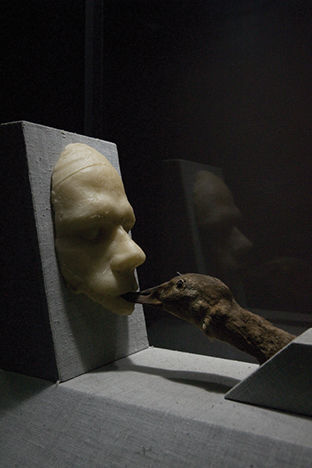The Museum of Jurassic Technology, located in Culver City, was founded by David Hildebrand Wilson and Diana Drake Wilson (husband and wife). It traveled for several years before settling on Venice Boulevard in late 1987.
The introduction on the museum’s website begins: “The Museum of Jurassic Technology in Los Angeles, California, is an educational institution dedicated to the advancement of knowledge and the public appreciation of the Lower Jurassic.”
The Wikipedia entry adds: “The factual claims of many of the museum’s exhibits strain credibility, provoking an array of interpretations from commentators.”
In laywoman’s terms, the MJT is simultaneously utterly serious, utterly tongue-in-cheek, and a kind of elaborate gift/puzzle/koan.
The first time I wandered in I felt like I’d encountered a part of my psyche I’d always known existed but had never quite yet met in the flesh.
The place was pitch-black. In the background were what sounded like scratchy Victrola recordings of baying dogs, thunderclaps, possessed monks, dying nuns and children consigned to limbo.
There were deteriorating dice, a spectral green, from the collection of illusionist Ricky Jay.
There were floral stereoradiographs of Albert G. Richards, black-and-white X-rays of flowers so hauntingly beautiful that when I came across them in the dark, I first gasped, then wept.
There was an exhibit — “Tell the Bees: Belief, Knowledge, and Hypersymbolic Cognition” — that could just as well have been called “Insane Old Wives’ Tales.”
But were they insane?
“Twilight and night flying white moths are the souls of the dead, who in this form are allowed to take farewell of this earth.” “Shrikes and plovers are known to contain the souls of those who assisted at the crucifixion, and person who hear the cries of these ‘wandering souls’ are sure to meet mischance.”
To believe that in the Transubstantiation, the bread and wine become the Real Body and the Real Blood of Christ, is to be open to the possibility that ecstatic truth — the truth that comes from the marriage of imagination and memory, magic and heart — is not only true, but somehow truer than true.
To that end, what fascinated me almost as much as the museum itself was the museum as calling, starting with a kind of conversion experience in Wilson’s late teens, as described in writer Lawrence Weschler’s splendid “Mr. Wilson’s Cabinet of Wonder” (1995). “It was like something was being given to me — somewhere between a gift and an assignment.”
The ensuing story reads like the museum’s exhibits: The years when the museum was essentially Diana and himself, doing exhibits around town; the looking all over L.A. and finally spotting a “For Lease” sign in Culver City for a building with rent that was affordable only because it was to be torn down in a year; the mysterious moratorium on building strip malls so that the one year stretched into five; the attendance so sparse that if 10 people showed up on a weekend, he and Diana would go out and celebrate; the 1,600 extra square feet of space David happened upon behind a panel one day, allowing the museum, over time, to expand.
He had a small special effects film business he could have ridden into digitization and made a tidy bundle from, then retired.
Instead they continued to pour “all the money we didn’t have” straight into the museum: exhibits, buildings, whatever it took.
“Doing this crazy project there was a sense of almost testing the universe. What if you were to put everything you had behind something you believe in? It’s a risk.
“Right when we were in danger of having no income at all, we had a kid, DanRae. The rent doubled. I didn’t sleep through the night for … decades.”
He doesn’t sleep during the night now. He lives in a trailer behind the museum and wakes up throughout the night to check on strange noises, possible ceiling leaks, the ring-necked doves who roost in the garden outside the second-floor Tula Tea Room.
But perhaps most wondrous of all is his refusal to take credit for his sui generis creation.
“I always knew that the ideas came through me, not from me. But the process of making things became so much richer once I discovered collaboration.
“After a while people started liking the stuff.” (In the two hours we talked, David never once mentioned the Weschler book, the MacArthur Foundation “genius grant” he received in 2001, or the now worldwide legion of MJT fans).
“Over time we developed a group of six or so, all of whom could make quadruple the money somewhere else, who work here. They’re incredibly talented. We couldn’t possibly maintain without them.
“When we finish something, there’s a certain period, before the exhibit opens, where we just sit. Experience. Drink it in. At some point, we’ll say, ‘That’s great. That really works. Whose idea was that?’
“And nobody remembers.”
David almost invariably uses the pronoun “we” rather than “I.” That “we” could refer to himself and Diana. It could refer to those devoted staff members. Or it could refer to — well, as a priest friend says, “If it’s too good to be true? That’s how you know it’s God.”

